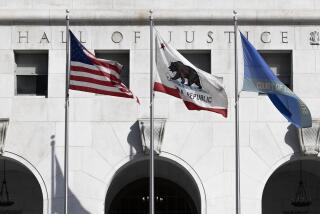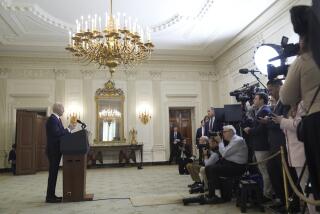Court TV Founder Defends Live Trial Coverage
Faced with the disturbing prospect that live courtroom coverage of trials could be drastically curbed in California, the founder of Court TV issued a ringing defense of live coverage Wednesday, declaring that cameras in courts are based on the nation’s deeply rooted tradition of public trials.
“The framers of the Constitution didn’t require public trials because they wanted to throw a symbolic bone to the public or to the press, but because they thought public trials were part of the essence of what a trial was in colonial America and in the mother country before that,” Steven Brill, chief executive officer of Court TV, said in a Century City speech to the Los Angeles County Bar Assn.’s Intellectual Property and Entertainment Law wing.
“Trials were meant to be highly public events, not just official proceedings offering minimal public access” afforded by small courtrooms with room for few spectators, he said. In the O.J. Simpson trial, only seven seats were available for members of the public.
Brill acknowledged that the Simpson trial left Americans with a distorted impression of the legal system but said “the answer . . . left by one aberrant case is not to make it so that the public will not see any other cases.”
He stressed that Court TV televised 33 other cases during the Simpson trial, including two in California, in which “the judge had no problem controlling his or her courtroom and where the dignity of the process was on display for millions of Americans to see.” Of the 430 cases that Court TV has televised since its birth, 46 have been California trials.
Brill made the speech as a special task force of the California Judicial Council, in the wake of criticism spawned by the Simpson trial, is considering proposals to change current state procedures permitting live courtroom coverage. Chief Justice Malcolm M. Lucas convened the task force three weeks after Simpson was acquitted of murder charges.
Film and electronic coverage of California courtroom proceedings have been permitted since 1980. Under California Court Rule 980, a judge may refuse, limit or terminate film or electronic media coverage in the interests of justice, to protect the rights of the parties and the dignity of the court, or to ensure the orderly conduct of the proceedings.
Gov. Pete Wilson, state Sen. Quentin Kopp (I-San Francisco) and a number of jurists have urged that the state’s judges be stripped of the discretion they now have under California Court Rule 980 to allow cameras to record and broadcast court proceedings.
“Rule 980 is a bad experiment that has failed,” Judge Mary Ann Murphy, representing Presiding Judge Gary Klausner and the Los Angeles Superior Court Committee on cameras in the courts, said at a hearing in San Francisco last week.
Brill said he was disheartened that the Simpson case had engendered such a strong reaction.
“For 15 years no one in the California legal community, including this governor, had a bad thing to say about cameras in the courts,” Brill said. “Suddenly, because one case arguably made the system look bad and perhaps because one judge--unlike the other judges in high-profile cases Court TV and others televised--had trouble handling the public glare, some want to throw the cameras out,” Brill said in a pointed reference to Superior Court Judge Lance A. Ito.
Brill also took issue with Wilson’s legal affairs secretary, Dan Kolkey, who said it was a good thing that the 1995 New York trial of those charged with a terrorist conspiracy to blow up New York landmarks and the Holland Tunnel had “slipped from the public consciousness” because it had not been televised.
“Would the Founding Fathers have thought that was a good thing?” Brill asked rhetorically. “Wouldn’t it have been better for Court TV and CNN and others to have televised that New York bombing conspiracy trial--which involved basic issues of national security juxtaposed against defense charges of entrapment and official misconduct--instead of having it ‘slip from the public consciousness?’ ”
Despite his vigorous public defense of live coverage, Brill has drawn criticism because of a proposal he made recently in an attempt to head off a ban on live coverage.
Brill has advocated that networks restrict analysis by commentators, that a network that begins in-court coverage be required to keep a camera there until a trial’s end, that pool media outlets be prohibited from using any coverage for advertising or promotional purposes, and that any other electronic equipment in the courthouse except that being used for in-court coverage be banned. That latter requirement would effectively bar live courthouse interviews and news conferences of the kind held during the Simpson trial and other cases here.
Brill also suggested that courts “not allow the televising of any pretrial proceeding or any proceeding during the trial that is not being conducted with the jury present . . . and if the camera coverage, as compared to the general media coverage of such a hearing, is likely to endanger a fair trial.”
Terry Francke, executive director of the California First Amendment Coalition, a group consisting of seven media organizations, has urged the Judicial Council Task Force to reject Brill’s proposals as “unwise, unnecessary and . . . constitutionally suspect.” The California Newspaper Publishers Assn., of which The Times is a member, is part of the coalition.
More to Read
Sign up for Essential California
The most important California stories and recommendations in your inbox every morning.
You may occasionally receive promotional content from the Los Angeles Times.










